Capital District
| Capital District | |
| Capital Region | |
| Region | |
 | |
| Name origin: Region of the capital of the state of New York | |
| Country | |
|---|---|
| State | |
| Counties | 11
|
| City | Albany, New York |
| Cities and towns | 13 and 143 |
| Area | 7,228 sq mi (18,720 km2) |
| Population | 1,170,483 (2013) |
| Density | 161.4/sq mi (62/km2) |
| Timezone | EST (UTC−5) |
| - summer (DST) | Eastern Daylight Time (UTC−4) |
| Area code | 518 |
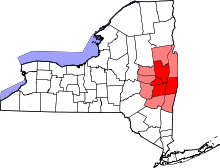 Core Capital District counties
Peripheral counties | |
| Wikimedia Commons: New York Capital District | |
| Website: http://www.cdrpc.org/ http://www.cdtcmpo.org/ | |
| Part of a series on |
| Regions of New York |
|---|
 |
|
Timelines of town creation
|
The Capital District, also known as the Capital Region, refers to the metropolitan area surrounding Albany, the capital of the U.S. state of New York. With a population of 1,170,483 (2013), the Capital District is the fourth largest metropolitan region in the state[1] and the 45th largest in the country.[2] Companies that have headquarters in Albany include CommerceHub and the Environment One Corporation.[3] In the 21st century, the Capital District has emerged as a major anchor of Tech Valley, the moniker describing the technologically-focused region of eastern New York State. The Capital District was first settled by the Dutch in the early 17th century and came under British control in 1664. Albany has been the permanent capital of the state of New York since 1797. The Capital District is notable for many historical events that predate the independence of the United States, including the Albany Plan of Union and The Battles of Saratoga.
Etymology
The term Capital District is commonly used to refer to the area due to its location surrounding the state capital. This is similar to other capital districts throughout the world, all of which are associated with a respective capital city. The earliest reference to the name "Capital District" stems from the planned metropolitan area surrounding Albany,[4] which was attempted by the state in the late 1760s comprising land that is now the cities of Albany, Troy, Rensselaer, Watervliet, and Cohoes; along with what are now the towns of Colonie (including the villages of Colonie and Menands), Green Island, North Greenbush, and East Greenbush.[5] Later, Schenectady was added to this district as well.[6]
In the 1810s several economic and government organizations covering the area also used Capital District in their name, such as the Capital District Conference of Charities and Corrections in 1813,[7] the Capital District Life Underwriters Association also in 1813,[8] and the Capital District Recreation League.[9] The Capital District Recreation League, formed in 1816, proposed a Capital District Park (also referred to as the Six City Park) to be roughly 8 miles (13 km) from Albany, Cohoes, Rensselaer, Schenectady, Troy, and Watervliet. The location proposed was the area of the Shaker settlement.[9] The park was never created, though in 1928 the location was used for Albany International Airport for the same reason of its central location to those suburbs.
Nicknames
Capitaland, Metroland, and Tech Valley are nicknames sometimes used to refer to the Capital District.[10] Different uses of the names Capital District, Capital Region, and Eastern New York may sometimes be used on regions that include Hamilton County; and the extreme northern portions of the Mid-Hudson Valley, usually Ulster and Dutchess counties; or extreme southern sections of Essex County.[11]
The Capital District is a part of the area marketed under the name Tech Valley in recognition of the technology companies that have moved to the region, or are being wooed by governmental or educational institutions to relocate to the area. The 19-county region, which extends from the Canada–US border south to Orange County,[12] is marketed by organizations such as the Tech Valley Chamber Coalition, the Albany-Colonie Regional Chamber of Commerce, and the Albany-based Center for Economic Growth.[13]
History
First settlements

Permanent European claims and settlement began in 1609 when Henry Hudson sailed north up the Hudson River in the name of the Dutch.[14] During the same year, Samuel Champlain explored south down Lake Champlain and Lake George in the name of France.[14] Conflict soon ensued between the French and Dutch for control of the fur trade and both made alliances with different Native American tribes.[15] In 1630, Kiliaen van Rensselaer founded the Manor of Rensselaerswyck, a Dutch patroonship in the area, which encompassed much of the area that is now the Capital District.[16] In 1664 the English successfully conquered the Dutch while rivalry with the French continued.[17] The Dutch, and then the English, maintained focus on settlement and farming while the French incursion into this area was limited to hunting for furs, trading with the natives, and building a few forts. Conflict arose when the French-built Fort Carillon and the British-built Fort William Henry near each other, both in order to control the route between the Hudson River Valley and the Champlain Valley.
Through the Dongan Charter, Governor Thomas Dongan granted Albany the right to purchase 500 acres (2.0 km2) in "Schaahtecogue" (today Schaghticoke, in Rensselaer County)[18][19] and 1,000 acres (4.0 km2) at "Tionnondoroge" (today Fort Hunter, in Montgomery County).[18][20] Arent van Curler founded Schenectady in 1662; Fort Saratoga was built at present-day Schuylerville in 1691; and Greenbush (present-day city of Rensselaer) was settled in the 1620s. South of Albany, settlement occurred quickly at first, but slowed as growth on the frontier pushed people north and west of Albany and left the southern reaches of the Capital District behind. Hudson, in Columbia County, was purchased from the natives in 1662 by Dutch farmers and speculators but did not see actual settlement and growth until 1783 when New Englanders, mainly from southeastern Massachusetts and Rhode Island, arrived.[21] It was chartered as a city in 1785, becoming only the third city in the state.
The French and Indian War saw several major battles in the Capital District, including at the aforementioned forts. In the end, the French were defeated, freeing the land for further settlement to the west and north of Albany. During the American Revolution the area again saw fighting and Fort Ticonderoga experienced notable action. The Battle of Saratoga, which took place in the present-day town of Stillwater, is considered the turning point of the war. In 1776, General Philip Schuyler built a small fleet of ships at Whitehall. They were used by Benedict Arnold in the Battle of Valcour Island. The event led to Whitehall's modern-day claim to be the birthplace of the United States Navy.[22]
After the Revolution, settlements continued to proliferate west and north of the Albany area. North of Albany, along the river, settlements grew quickly: Waterford (oldest continuously incorporated village in the US, incorporated in 1794),[23] Troy (settled in 1787, chartered as a village 1801, city in 1816), Lansingburgh (a village in 1763, annexed to Troy in 1900), and Watervliet (settled in 1643 and incorporated as a village in 1836 as West Troy, city in 1897). West from Schenectady, land purchases in the 1750s led to settlements at Fonda and Fultonville in Montgomery County, but land purchases elsewhere, such as at Gloversville in Fulton County did not see settlement until the end of the 18th century when the Iroqouis threat had been eliminated by the Sullivan Expedition in 1779, which came as retaliation for the Cherry Valley Massacre in nearby Otsego County.
Creation of the counties

The entire area of the Capital District was within the original boundaries of Albany County as established by the Province of New York on November 1, 1683; it was one of the original 12 counties.[24][25] In 1772, Charlotte County and Tryon County were both formed from parts of Albany County. Charlotte County was renamed Washington County in 1784, and from part of that, Warren County was created in 1813.[26] Tryon County was renamed Montgomery County in 1784, and from part of that, Fulton County was created in 1838.[26] Tryon County was large: it encompassed the lands from five miles (8 km) west of Schenectady to the western indeterminate boundary of the Province of New York.[27]
What remained of Albany County in 1774 became the most populated county in the state with a population of 42,921 and it continued to be the most populous county until at least 1790, when the population was 75,921.[25] Albany lost population as new counties were created from within: Columbia County was created in 1786; Rensselaer and Saratoga counties were formed in 1791; Schoharie County was created in 1795 from parts of both Albany and Otsego counties (Otsego having been created from part of Montgomery County in 1791); Greene County was formed in 1800 from parts of both Albany and Ulster counties; Schenectady County was created in 1809; and Warren County was formed in 1813 from Washington County. Fulton County was the last county in the Capital District to be formed.[26] A graphical representation of the county breakup timeline can be seen below.

Urbanization and transportation
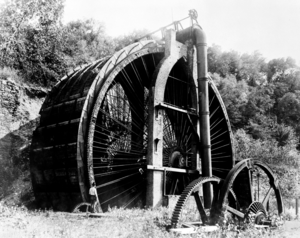
Many geographical features weighed heavily in the area's early industrialization. The abundance of small creeks with waterfalls led to early adoption of the waterwheel, while water navigation south on the Hudson and land routes west along the relatively flat Mohawk Valley allowed for easy access to and from resources and markets in those areas. In the late 1790s stage lines began to connect the various cities and villages in the area; this network would then connect the area to the rest of the country in the early 19th century. The early 19th century also saw the rise of turnpikes (the Great Western Turnpike would be the first in 1799), plank roads, and post roads. It was in Albany in 1809 that Robert Fulton first demonstrated that steam boats could be economically successful with a trip to the city of New York. In 1813, to support the army in the War of 1812, the US government built the Watervliet Arsenal in West Troy, one of the earliest large scale industrial complexes in the Capital District. In 1823 the Federal Dam was built on the Hudson, allowing for navigation north past Troy to Waterford and Cohoes. The Champlain and Erie canals were opened in 1823 [28] and 1825,[29] respectively. Their completion connected the area to the Great Lakes and Saint Lawrence River, leading to a large influx in industrialization and immigration. Shortly after the completion of the canals, in 1831, the Mohawk and Hudson Railroad Company (M&H) built the Albany and Schenectady Railroad between those two cities. This was the first railway in the state. Railroads, like the plank/post roads and canals before them, made Albany an even more important transportation hub. In 1853 Erastus Corning consolidated 10 railroads stretching from Albany to Buffalo as the New York Central Railroad, headquartered in Albany until Cornelius Vanderbilt took over in 1867 and moved the company to New York City.[30]
Industry consequently became prominent in the area. Gloversville was labeled the "headquarters of the glove and mitten industry" and became the preeminent glove-manufacturing and leather-working region in New York.[31] Cohoes became known as the Spindle City for its large cotton mills, due mainly to Harmony Mills, the largest cotton mill complex in the world when it opened in 1872. Troy became famous for its iron works due to Burden Iron Works,[32] though later Troy would earn the nickname of Collar City due to Cluett, Peabody & Co., which made Arrow brand shirts at the largest collar, cuff, and shirt factory in the world at the time.[32] In 1887 Thomas Edison moved his Edison Machine Works to Schenectady, and in 1892 Schenectady became the headquarters of the General Electric Company (GE).[33] Schenectady Locomotive Works, along with seven other locomotive manufacturers, merged in 1901 and the American Locomotive Company (ALCO) was formed and headquartered in Schenectady.[34] Due to the dominance of GE and ALCO in their respective industries, Schenectady would gain the nicknames of Electric City and "The City that Lights and Hauls the World". The nature of this industry lent itself to the creation of many labor-saving inventions, such as the horseshoe machine of Henry Burden, the pre-shrinking fabric machines of Sanford Cluett, the power knitting loom of Timothy Bailey, the railroad air-brake of George Westinghouse, and the hundreds of electricity-related improvements of General Electric Company scientists.[32]
Rise of the suburbs and urban decline
Starting with the 1980 US Census, Albany posted a decline in population until the 2000 US Census. Meanwhile, the suburbs saw an influx in population and grew at the expense of the city of Albany.[35] There were many causes to this, including the building of interstates and other highways allowing for more commuting, lack of available suitable land within the urban centers, and the subsequent location of shopping centers following the people to the suburbs.
The decline of exporting from the United States contributed to a general decline as well. Watervliet, Cohoes, and especially Troy lost a competitive edge that came with being at the confluence of the Hudson and Mohawk rivers: the location no longer meant better access to markets, waterfalls no longer made the cheapest power, and cheap labor in the southern and western parts of the nation became important to companies.[36] General Electric moved part of their headquarters to Connecticut from Schenectady in the mid-80s.[37] Within the Capital District focus shifted to the suburbs. The suburbs had large open spaces for office parks and homes while the cities were constrained in available land. Albany International, with their headquarters and factory straddling the Menands and Albany border, built a new headquarters in 1987 in suburban East Greenbush,[38] as did Garden Way, headquartered in Troy.[39] The region's first technology park was built in the 1980s in North Greenbush by Rensselaer Polytechnic Institute (RPI).[40]
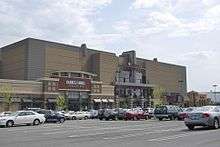
Not only was there a shift in population to the suburbs, there was also a shift in retail shopping as well; retail sales in the cities declined a percent between 1972 and 1987, having increased 63 percent in the suburbs.[41] In 1957 Westgate Plaza became the first "suburban"-style shopping center in the area; it was and still is within the city limits of Albany however, but then two years later in 1959 Stuyvesant Plaza was built outside Albany in the neighboring town of Guilderland.[42] 1966 saw the opening of Colonie Center, the area's first enclosed shopping mall.[42] When built it drew shoppers from hundreds of miles from Albany.[42] Macy's, which only had locations in the New York City area, and Sears originally wanted to build in downtown Albany, but interference from Mayor Erastus Corning 2nd led to those stores choosing to move into suburban Colonie Center instead.[43] Problems with Mayor Corning would also force the Albany Times Union newspaper to move from Albany to Colonie in the 1970s. Crossgates Mall is a large upscale mall that was built in the suburb of Guilderland in 1984. A modern expansion in 1994 drew luxury anchor Lord & Taylor to the mall and added another Macy's which was exclusive to the region.
Five more enclosed malls were built in the next ten years, all outside of Albany limits: Rotterdam Square outside Schenectady, Wilton Mall in Saratoga Springs, Aviation Mall in Queensbury, and Clifton Park Center in Clifton Park.[42] The first mall built within a downtown area was completed back in 1977 as the Amsterdam Mall in Amsterdam.[44] The next year, Troy opened the Uncle Sam Atrium,[42] and in 1986 Cohoes attempted Cohoes Commons, which is now office space.[45][46]
Urban revival
In the late 1980s historic parts of Albany, as well as areas of Schenectady, Troy, and Saratoga Springs all began to see intensive restoration with an influx of private investments. During the Pataki administration a plan (referred to as the "Albany Plan") was devised to move state workers out of the W. Averell Harriman State Office Building Campus and move them to the downtowns of Albany, Schenectady, Troy and Wolf Road in Colonie.[47] Just prior to and as part of the Albany Plan regional headquarters of NYSDOT were built on the corner of State and Broadway in Schenectady, state workers were moved to the Troy Atrium in Troy, and the DEC and Comptrollers buildings were built in Albany. Along with new state workers and buildings Albany also saw the refurbishment and renovation of the State Education Building, State Capitol, Smith Building, and the NY Court of Appeals. New construction also occurred at other levels of government with the building of the Albany County Family Court and with the city refurbishing the Palace Theatre.
Private investment in downtown Albany saw an influx of restaurants, bars, and nightclubs; especially on Pearl Street and the first new office high rise in 15 years was built on Broadway. In Schenectady the Metroplex Authority allowed for massive private investment on State Street in the vicinity of Proctor's Theatre. Along with Proctor's being expanded, two new hotels, a large movie theater, and the headquarters of Price Chopper moving Downtown from the suburbs of neighboring Rotterdam, that section has seen a huge revival.
Geography


The Capital District's most prominent geological features were formed by glaciers creating its major rivers and valleys through ancient mountain ranges. The Hudson River forms the Hudson Valley which is a north-south running valley through the core of the Capital District while its tributary the Mohawk River forms the Mohawk Valley which runs west from Schenectady, the Schoharie Creek, a tributary of the Mohawk, forms the Schoharie Valley which runs through Schoharie County. Major mountain ranges are the Adirondack Mountains in the northwestern area and the Appalachian Mountains along the southern and eastern sections. The Appalachians include the Rensselaer Plateau in Rensselaer and southeastern Washington counties; the Taconic Mountains along the Washington, Rensselaer, and Columbia counties' borders with Vermont, Massachusetts, and Connecticut; the Allegheny Plateau in Schoharie, Greene, and western Albany counties, which includes the Helderberg Escarpment in Albany County; and the Catskill Mountains in Greene County. Major lakes include the Great Sacandaga Lake in Saratoga and Fulton counties, Saratoga Lake in Saratoga County, and Lake George in Warren and Essex counties.
Location
 |
Adirondack Mountains | North Country | Vermont |  |
| Central New York | |
Massachusetts | ||
| ||||
| | ||||
| Southern Tier | Mid-Hudson Valley Region | Connecticut |
Climate
| Albany | ||||||||||||||||||||||||||||||||||||||||||||||||||||||||||||
|---|---|---|---|---|---|---|---|---|---|---|---|---|---|---|---|---|---|---|---|---|---|---|---|---|---|---|---|---|---|---|---|---|---|---|---|---|---|---|---|---|---|---|---|---|---|---|---|---|---|---|---|---|---|---|---|---|---|---|---|---|
| Climate chart (explanation) | ||||||||||||||||||||||||||||||||||||||||||||||||||||||||||||
| ||||||||||||||||||||||||||||||||||||||||||||||||||||||||||||
| ||||||||||||||||||||||||||||||||||||||||||||||||||||||||||||
The Capital District has a humid continental climate, with cold, snowy winters, and hot, wet summers. Albany receives around 36.2 inches of rain per year, with 135 days of at least .01 inches of precipitation. Snowfall is significant, totaling about 63 inches annually,[49] but with less accumulation than the lake-effect areas to the north and west, being far enough from Lake Ontario. The core of the region is however, close enough to the coast to receive heavy snow from Nor'easters, and the region gets the bulk of its yearly snowfall from these types of storms. The region also occasionally receives Alberta clippers. Mohawk–Hudson convergence occasionally prolongs snowfall events in the Capital District, where precipitation has ended elsewhere across the region.[50] Winters are often very cold with fluctuating conditions, temperatures can drop to below 0 °F (−18 °C) at night. Summers in the region can contain stretches of excessive heat and humidity, with temperatures above 90 °F (32 °C) and dew points near 70. Severe thunderstorms are common but tornadoes are rare.
Albany receives on average per year 69 sunny days, 111 partly cloudy days, and 185 cloudy days;[51] and an average, over the course of a year, of less than four hours of sunshine per day, with just over an average of 2.5 hours per day over the course of the winter.[52] The chance during daylight hours of sunshine is 53%, with the highest percentage of sunny daylight hours being in July with 64%, and the lowest month is November with 37%.[49]
Cityscape

Architecture

The Capital District, having a history of settlement stretching back 400 years, has had many different architectural styles built over the years. Early Dutch farmhouses are still standing in the rural towns, especially west of Albany, such as the Mabee House. The Van Ostrande-Radliff House (1728) in Albany and the Rosa House in Schenectady (before 1700) are the oldest houses in each city. In 1885 American Architect and Building News, a magazine with national circulation, polled its readers asking what the nation's Top Ten most beautiful buildings were. Two buildings in the city of Albany made the list: Albany City Hall and the New York State Capitol; both finished in 1883 and designed by Henry Hobson Richardson.[53]
Troy has many distinctive features in architecture that sets it apart, such as its ornamental ironwork, cast-iron storefronts such as the Arts Center of the Capital Region, and the abundance of windows by Tiffany such as St. John's Episcopal Church, Troy Public Library, and St. Paul's Episcopal Church.[54] The Capital District also has a large selection of brownstone buildings especially in the Center Square neighborhood of Albany and the Washington Park neighborhood in Troy. Washington Park in Troy is one of only two privately owned urban ornamental parks in the state.[55]
Schenectady's Stockade neighborhood has representations of residential architecture from all periods in its 300-year history including Dutch, Federal, Greek Revival, Gothic Revival, and Victorian.[56] Also in Schenectady is the GE Realty Plot built by General Electric as homes for their employees,[57] the houses are in revival styles such as Tudor, Georgian, Queen Anne, Dutch Colonial, and Spanish Colonial.[58] The first all electric house was built by GE in the Realty Plot to showcase its products.[56] In Albany's Pine Hills neighborhood is a style of residential architecture that is rare in the rest of the Capital District, bungalows in the Spanish revival style, with red tile roofs and stucco walls, only 27 still exist and are the remnants of the Winchester Gables development.[59]
Parks
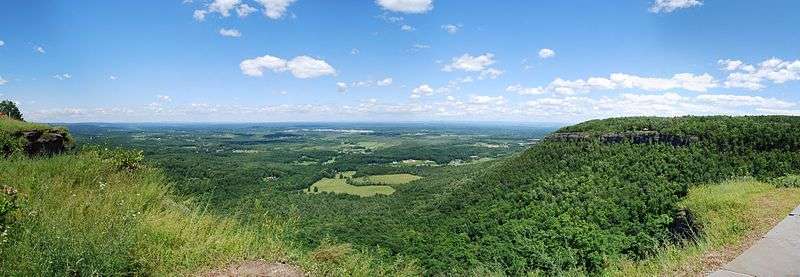
For recreation the Capital District has many state and local parks, preserves, hiking trails, public pools, and ice skating rinks.
The following state parks are in the Capital District: Cherry Plain, Max V. Shaul, Saratoga Spa, Grafton Lakes, Mine Kill, Schodack Island, Hudson River Islands, Moreau Lake, Thompson's Lake, John Boyd Thacher, and Peebles Island.[60] While they are frequently referred to as state parks, the Adirondack Park and Catskill Park have much more in common with a national forest: they mix private with public land and have year-round residents within their boundaries in long-established settlements. The boundaries of the Adirondack and Catskill parks are often referred to as the Blue Line. Parts of Fulton, Saratoga, Warren, and Washington counties are in the Adirondack Park. Much of Greene County is in the Catskill Park
The various municipalities of the Capital District have established many parks, small and large, for the recreational enjoyment of the residents and visitors of the area. Central Park in the city of Schenectady has over 4,000 individual rose bushes of between 300 and 400 different varieties in its rose garden at the Wright Avenue entrance.[61] Washington Park in Albany is home to many festivals, including the TulipFest and the LatinFest.
Festivals
One of the largest events in the Capital District is the Tulip Fest held in Albany every spring at Washington Park. The tradition stems from when Mayor Erastus Corning 2nd got a city ordinance passed declaring the tulip as Albany's official flower on July 1, 1948. In addition, he sent a request to Queen Wilhelmina of the Netherlands to name a variety as Albany's tulip. On July 11, 1948 her reply was "Her Majesty gladly accepts the invitation to designate a tulip as the official flower of Albany." She picked the variety "Orange Wonder", a bronzy orange shaded scarlet. The first Tulip Fest was celebrated the next year on May 14, 1949 with opening ceremonies still carried on today as tradition, such as the sweeping of State Street and the crowning of a Tulip Queen.[62] The African-American tradition of Pinksterfest, whose origins are traced back even further to Dutch festivities, was later incorporated into the Tulip Fest. Attendance to the festival in 2010 was approximately 80,000.[63]
The largest Flag Day parade in the United States is held every year in Troy. The 42nd annual parade in 2009 is along a two-mile (3 km) long route.[64] First Night celebrations are held in Saratoga Springs, while in 2006 Albany decided to eliminate its First Night celebrations in favor of a new "Albany WinterFestival" (WinterFest).[65]
Other major festivals in the Capital District include ethnic festivals. The Albany LatinFest, which has been held since 1996, drew 10,000 people to Washington Park in 2008.[66] In Schenectady the growing Guyanese community has celebrated the Guyanese Family Fun Day for several years in that city's Central Park.[67] PolishFest is a three-day celebration of Polish culture in the Capital District, held in the town of Colonie for the past eight years.[68]
Amusement
The Capital District has many enclosed malls that are regional malls (malls over 400,000 sq ft (37,000 m2) ), and two that are classified as super-regional malls (malls with over 800,000 sq ft (74,000 m2) ).[69] Crossgates Mall in Guilderland and Colonie Center in Colonie are the two super-regional malls with over 1,000,000 square feet (93,000 m2) of rentable space in each. Regional malls are located in Schenectady, Saratoga, and Warren counties.
In the Capital District are several regional amusement parks and water parks. The Great Escape & Splashwater Kingdom is a Six Flags park in Queensbury with an indoor waterpark and hotel across the street. Zoom Flume Water Park is in East Durham. Hoffman's Playland in the town of Colonie is a children's amusement park.
During the winter months the Capital District has many places to go for such cold-weather activities as skiing, snowboarding, tubing, ice fishing, snowshoeing, snowmobiling, and ice climbing. Some downhill ski centers include Maple Ski Ridge in Schenectady County, Willard Mountain in Washington County, Windham Mountain and Hunter Mountain in Greene County, West Mountain and Hickory Ski Center in Warren County which has the sixth highest vertical drop in the state.[70] In addition to downhill skiing most also have cross-country skiing trails as well. There are also cross-country trails at the state parks in the area, the Schenectady County Forest in Duanesburg and Pine Ridge XC Ski Area in Rensselaer County. There are over 18 miles (29 km) of official trails for snowshoeing at the Albany Pine Bush Preserve.[71]
Municipalities
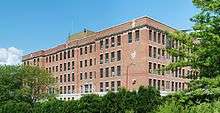
The 11 counties of the Capital District are divided into 13 cities and 143 towns, with 62 villages that are inside one or more towns. One village, Green Island is coterminous with its town and share only one government institution. The municipalities in the Capital District range in size from villages with a few hundred residents to Albany (the largest city) with over 95,000 and Colonie (the largest town) with over 80,000.
- Albany County (pop. 304,204) is the largest county by population in the area, the largest city in the Capital District- Albany, and the largest town- Colonie, are within this county. State government dominates the economy.
- Columbia County (pop. 63,094) is coterminous with the Hudson Micropolitan Statistical Area (μSA). Hudson is the largest city and the county seat.
- Fulton County (pop. 55,073) is coterminous with the Gloversville μSA. Gloversville and Johnstown are popularly referred to as the Twin Cities or Glove Cities.[72] Johnstown is the county seat and Gloversville is the largest city.
- Greene County (pop. 48,195) is the only county in the Capital District outside the Albany-Schenectady-Amsterdam CSA. The village of Catskill is the county seat.
- Montgomery County (pop. 49,708) is coterminous with the Amsterdam μSA, county seat is the village of Fonda, largest city is Amsterdam. Largest employer is St. Mary's Hospital.[73]
- Rensselaer County (pop. 152,538) is the third largest county by population, Troy is the largest city and the county seat. Rensselaer Polytechnic Institute is a world-renowned college.
- Saratoga County (pop. 200,635) is the second largest county by population. Saratoga Springs is the largest city and Ballston Spa is the county seat. The Saratoga Race Course brings thousands of tourists each August.
- Schenectady County (pop. 146,555) is the birthplace of General Electric and still retains the core of its alternative energy production. The city of Schenectady is the largest city and county seat.
- Schoharie County (pop. 32,749) is a rural county in the Albany-Schenectady-Troy MSA. Schoharie is the county seat.
- Warren County (pop. 63,303) contains the highest concentrated area of medical manufacturers in the state, with many medical inventions originating in the county.[74] Queensbury is the county seat and Glens Falls is the only city and largest municipality.[75]
- Washington County (pop. 61,042) is a rural county in the Glens Falls MSA, Fort Edward is the county seat.
Culture and contemporary life
Culture
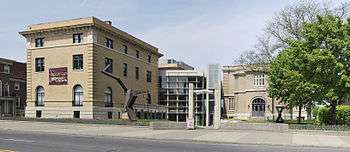
Albany consistently ranks high on lists of top cities/metro areas for culture, such as being 23rd in the book Cities Ranked & Rated.[76] Albany ranked 12th among large metro areas and Glens Falls ranked 12th among the small metro areas in Sperling's Best Places;[77] and Expansion Management (a monthly business magazine) gave the Albany-Schenectady-Troy area five Stars, its highest ranking, for quality of life features.[77] The Capital District has many museums, historical sites, art galleries, and festivals that stretch back to the 17th century. The Capital District has been pivotal in the history of Santa Claus in the United States including the first written reference to Santa (Sinterclaas) in 1675 and the first publishing of 'Twas the Night before Christmas in 1823.[78][79]
Media market
The Albany-Schenectady-Troy media market, the 56th largest in the United States,[80] includes all of the 11 counties of the Capital District, along with Hamilton County, New York, as well as Berkshire County, Massachusetts, and Bennington County, Vermont. In total, there are 16 AM/MW stations, 30 full-power FM stations, 14 low-power FM translators, 8 full power analog TV stations, 5 low-power TV translators, and 8 full power digital TV (DTV) stations licensed to communities within 30 miles (48 km) of downtown Albany.
In terms of broadcast media, Albany is part of Arbitron market #63 (radio), and Nielsen DMA #57 (television), and is a broadcast market with historical relevance. The pioneering influence of General Electric in Schenectady directly contributed to the area emerging as the birthplace of station-based television (WRGB), WRGB also has the distinction of being the very first affiliated station of the NBC Television Network. In 1947, this region was also home to the first independently owned and operated stand-alone FM radio station in the United States, W47A and one of the earliest FM broadcast stations (today's WRVE), in addition to the first federally licensed radio station in upstate New York, WGY. In the early 2000s, the greater Albany market had the distinction of having the highest concentration of FM broadcast stations east of the Mississippi River. There are no radio stations in the Albany area that provide programming in languages other than English on a full-time basis. A few individual programs; in languages including Spanish, Italian, and Arabic; are scheduled primarily on college owned and operated stations.
The Albany Times Union is the area's primary daily newspaper; its headquarters moved to suburban Colonie from Albany in the 1970s after a dispute with then-Mayor Erastus Corning 2nd over land needed for expansion. More localized are the Daily Gazette, which focuses primarily on Schenectady; the Troy Record, which focuses on Troy; The Post-Star, which focuses on Washington, Warren, and northern Saratoga counties; The Saratogian, which focuses on Saratoga County; the Amsterdam Recorder for Montgomery and Fulton County; the Gloversville Leader-Herald for Fulton County; the Daily Mail for Greene County; and the Register-Star for Columbia County. Metroland is the alternative newsweekly in the area, publishing each Thursday, while The Business Review is a business weekly published each Friday. Capital Region Living is a monthly magazine available in Albany, Columbia, Fulton, Greene, Montgomery, Rensselaer, Saratoga, Schenectady, Warren, and Washington counties in New York; Bennington and Rutland counties in Vermont; and in Berkshire County, Massachusetts.
Cuisine

The Capital District has been the birthplace of several important foods in American food culture. Potato chips were invented by African-American/Native American chef George Crum, at the Moon Lake Lodge's restaurant in Saratoga Springs. The club sandwich was also invented in Saratoga Springs, at the Saratoga Club-house, today the Canfield Casino, in 1894.[81] Pie à la Mode was first made at the Cambridge Hotel in Cambridge, Washington County in the 1890s.[82][83]
Sturgeon in the Hudson River was once so plentiful that the fish was referred to as "Albany beef".[84]
Sports

Though the Capital District is not well known for its sports teams it does have a rich history of professional teams and college athletics. The Troy Trojans were a Major League Baseball team in the National League for four seasons from 1879 to 1882. In 1883 the New York Gothams, later the New York and San Francisco Giants, took the Trojans place in the National League. Nearly half of the original Gotham players had been members of the Trojans.
NBA head coach of the Los Angeles Lakers Phil Jackson won his first championship ring when he guided the Albany Patroons to the 1984 CBA championship. Three years later, the Patroons completed a 50–6 regular season, including winning all 28 of their home games; at that time, Denver Nuggets head coach George Karl was the Patroons' head coach. Future NBA stars Mario Elie and Vincent Askew were part of that season's squad. A third NBA head coach has roots in the Capital District as well, Pat Riley, most famous as the coach of the Los Angeles Lakers, but also of the New York Knicks and Miami Heat. Riley played for Linton High School in Schenectady,[85] where he was also a football star. He also played on the Schenectady Little League Baseball team when in 1954 it won the Little League Baseball World Series. Aileen Durrant, from Stillwater High School, is the former New York State High School Softball Chairwoman and in 2012 she was inducted as part of the first class into the New York State High School Softball Hall of Fame
Mike Tyson received his early training in the Capital District and his first professional fight was in Albany in 1985 and Tyson's first televised fight was in Troy in 1986. He fought professionally four times in Albany and twice each in Troy and Glens Falls between 1985 and 1986.
Since 1988, the Siena College men's basketball team (the Siena Saints) have appeared in six NCAA Tournaments (1989, 1999, 2002, 2008, 2009, and 2010), while their crosstown rivals, the Great Danes of the University at Albany (SUNY) have appeared five times 2006, 2007, 2013, 2014 and 2015. The University at Albany has recently run a top 20 NCAA lacrosse program. The Capital District, however, has achieved its best success in NCAA hockey. Union College won the NCAA National Championship in 2014, while its rival, RPI, brought home the national title in 1985 and 1954[86]
Roller derby leagues in the area include Albany's Albany All-Stars Roller Derby and Troy's Hellions of Troy Roller Derby.[87]
Professional teams
- Albany Devils (AHL affiliate of the New Jersey Devils)
- Albany Legends (International Basketball League)
- Tri-City ValleyCats (New York–Penn League "short A" baseball, affiliate of the Houston Astros; 2010 New York–Penn League Champions)
- New York Buzz (World Team Tennis)
Economy
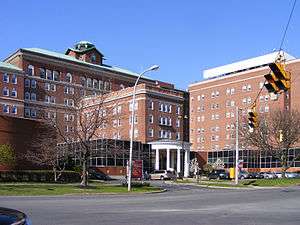
The economy of the Capital District was at the beginning of settlement by Europeans dominated by the fur trade, especially in beaver pelts, hence Albany's early name of Beverwyck. But as settlement grew and matured the economy became traditionally anchored by several large manufacturing industries, such as the glove and leather industry in Fulton and Montgomery counties, American Locomotive and General Electric in Schenectady, first steel and then the shirt industry in Troy, and lumber in Albany and Watervliet. Now the economy of the region is heavily anchored by the state as the largest employer in the eleven-county region,[88] employing thirteen percent of the non-farm workforce in the Capital District.[89] One-fourth of the area's workforce works for the state or local governments,[90] with the state of New York, the Federal government, and Albany County as the first, third, and eighth largest employers in the area. [88] There have traditionally been three legs holding up the region's economy- state government, health care, and education.[91] Health care provides a large and growing sector of the region's economy as well. Albany Medical Center, St. Peter's Health Care Services, and Northeast Health are the fourth, fifth, and sixth largest employers in the eleven-county Capital District.[88] Price Chopper, a privately owned grocery chain headquartered in Schenectady, is the 13th largest employer in the entire state of New York with 14,000 employees.[92]
Manufacturing has been disappearing but is still important, and makes up six percent of the non-farm workforce.[93] Major factories in the area are owned by General Electric, still the region's largest private-sector employer,[88] and spin-offs such as Momentive Performance Materials' plant in Waterford, Saratoga County and the SABIC plant in Selkirk, Albany County. Mechanical Technology Inc. (MTI) of Schenectady, another spin-off from General Electric, has helped put the region on the map for alternative energy production, as has its own spin-off, Plug Power of Latham and the Center for Future Energy Systems at Rensselaer Polytechnic Institute.
The Capital District has historically been linked to banking, finance, and insurance. Bank of Albany, founded in 1792, was the second bank established in the state,[94] and American Express was founded in Albany. Finance and insurance employs six percent of the workforce in the area.[95] Many important regional and national banks are headquartered in the area, such as Trustco Bank, and many national banks have regional headquarters in Albany, such as Bank of America and KeyBank.[96][97] Albank, Norstar, Troy Savings Bank, Hudson River Bankcorp, and KeyBank were all founded in the area and have either moved their headquarters out of the region, such as KeyBank in 1994,[98] or been merged into larger companies such as Hudson River Bankcorp into First Niagara Bank, out of Buffalo. Though Bank of America is the nation's largest bank it ranks only sixth in the region in bank deposits.[98] Citizens Bank is the region's largest bank by market share of deposit holdings (32.5%), while Trustco Bank is largest by number of branches (52) in the area, as defined by the Federal Deposit Insurance Corporation.[98]
Tech Valley

Since the 2000s, the economy of the Capital District has been redirected toward high technology. Tech Valley is a marketing name for the eastern part of New York State, encompassing the Capital District and the Hudson Valley.[99] Originated in 1998 to promote the greater Albany area as a high-tech competitor to regions such as Silicon Valley and Boston, it has since grown to represent the counties in the Capital District and extending to IBM's Westchester County plants in the south and the Canada–US border to the north. The area's high technology ecosystem is supported by technologically focused academic institutions including Rensselaer Polytechnic Institute and the State University of New York Polytechnic Institute.[100] Tech Valley encompasses 19 counties straddling both sides of the Adirondack Northway and the New York Thruway,[99] and with heavy state taxpayer subsidy, has experienced significant growth in the computer hardware side of the high-technology industry, with great strides in the nanotechnology sector, digital electronics design, and water- and electricity-dependent integrated microchip circuit manufacturing,[101] involving companies including GlobalFoundries in Malta, IBM in Armonk and its Thomas J. Watson Research Center in Yorktown Heights, and others.[100][102][103]
Demographics
The Capital District is New York's most affluent metro area outside of the New York City metropolitan area. Median household income was roughly $86,787[104] in 1999 and its educational attainment profile, with 28 percent of adults having a college degree, is slightly above state average and well-above the national average.[105]
Metropolitan and micropolitan statistical areas
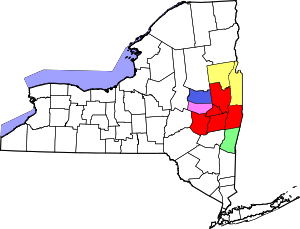
Albany-Schenectady-Troy
Glens Falls
Hudson
Amsterdam
Gloversville
The Albany Metropolitan Statistical Area (MSA) is defined by the Office of Management and Budget and includes Albany, Rensselaer, Saratoga, Schenectady, and Schoharie counties; makes up a large portion of the Capital District.[106] The A-S-A CSA is the vast majority of the Capital District, leaving out only Greene County. It has a population of 1,118,095 according to the 2000 US census,[107] and is ranked 38 out of the 169 CSAs in the US,[2] and is the third largest in the state. Adding the population of Greene County in the 2000 census, 48,195, to the population of the A-S-A MSA there is 1,166,290 persons in the 11 counties of the Capital District. The Albany MSA includes only interior counties and was ranked the 56th most populous in the United States of America in the 2000 census.[108] Exterior counties Warren and Washington, in the northern reaches, make up the Glens Falls Micropolitan Statistical Area (μSA); while Fulton County the Gloversville (μSA), formed in 1990, Montgomery County the Amsterdam μSA (formed in 1990 from Albany MSA), and Columbia County is the Hudson μSA (formed in 1990). The Albany MSA along with those Micropolitan Stat. Areas combine to form the Albany Combined Statistical Area (A-S-A CSA).[109]
Neighboring metro areas
 |
None | None | None |  |
| Utica-Rome MSA | |
Rutland, VT μSA Bennington, VT μSA Pittsfield, MA MSA | ||
| ||||
| | ||||
| None | New York-Newark-Bridgeport CSA (Kingston MSA Poughkeepsie-Newburgh-Middletown MSA) |
New York-Newark-Bridgeport CSA (Torrington, CT μSA) |
State and congressional representation
The Capital District is split between several different districts for representation in the New York Legislature and the United States Congress. Chuck Schumer[110] (D) and Kirsten Gillibrand[111][112] (D) represent the state in the United States Senate. The area contains three congressional districts. The 20th district makes up most of the south, east, and north of the Capital District, while much of the rest is part of the 21st district. A small part of Fulton County is part of 23rd district. Currently the districts are represented by Chris Gibson (R) (20th district),[113][114] Paul Tonko (D) (21st district),[115] and Bill Owens (D) (23rd district).
The area is represented in the State Legislature by nine Assembly districts and four Senate districts. For the Assembly the area is represented by Jack McEneny (D) of Albany (104th district);[116] George Amedore (R) of Rotterdam (105th district);[117] Ronald Canestrari (D) of Cohoes (106th district);[118][119] Timothy P. Gordon (I) of Delmar (108th district);[120] Robert Reilly (D) of Colonie (109th district);[121] James Tedisco (R) of Schenectady (110th district); [122] Tony Jordan (R), (112th district);[123] Teresa Sayward (R) of Willsboro (113th district);[124] and Peter Lopez (R) of Schoharie (127th district).[125] In the State Senate the area is represented by Roy McDonald (R) of Wilton (43rd district); [126] Hugh Farley (R) of Schenectady (44th district);[127] Betty Little (R) of Queensbury (45th district);[128] and Neil Breslin (D) of Albany (46th district).[129]
Education
School districts
In Albany, Rensselaer, Saratoga, and Schenectady counties there are 54 public school districts,[130] each of which is under the umbrella of one of four Boards of Cooperative Educational Services (BOCES) in the area: Capital Region BOCES,[131] Questar III (Rensselaer-Columbia-Greene BOCES),[132] Washington-Saratoga-Warren-Hamilton-Essex BOCES,[133] or Hamilton-Fulton-Montgomery BOCES.[134] Some of these districts cross county borders since school district boundaries are independent of town and county borders. The smallest district by student enrollment is North Greenbush Common School District, with 20 students in 2006[135] and the largest school district is Shenendehowa Central School District, with 9,745 students in the end of the 2008 school year.[136] Bethlehem Central High School is the highest ranked public high school in the Capital District.
Colleges and universities
By far the largest educational institution in the Capital District is The University at Albany, one of the four major university centers of the State University of New York. It has an enrollment of over 17,500 students from more than 100 nations at the graduate and undergraduate levels. Students can choose from 111 undergraduate majors and minors and 120-plus graduate programs. Many of these programs are nationally ranked, among them criminal justice, information technology, public administration, social welfare and sociology.
The colleges and universities of the Capital District have a long and distinguished heritage. Founded in 1795, Union College was the alma mater of President Chester A. Arthur.[137] Rensselaer Polytechnic Institute in Troy is the oldest continually existing technical university in the English-speaking world.[138] Albany Law, Albany College of Pharmacy, Sage College of Albany, and Albany Medical Center (which consists of Albany Medical Center Hospital and the Albany Medical College) are independent of each other but all share one campus as part of the University Heights Association, in Albany. Saratoga Springs is the home of Skidmore College, a liberal arts college founded in 1903. Also in the Capital District are two Catholic schools, Siena College, a school in the Francisican tradition located in Loudonville, and St. Rose College, founded by the Sisters of St. Joseph in the Pine Hills section of Albany. The Capital Region also boasts two Community Colleges; Schenectady County Community College in Schenectady and Hudson Valley Community College located in Troy.
Transportation
Albany has long been at the forefront of transportation technology from the days of turnpikes and plank roads to the Erie Canal, from the first passenger railroad in the state to the oldest municipal airport in the nation. Today, Interstates, Amtrak, and the Albany International Airport continue to make the Capital District a major crossroads of the Northeastern United States.
The Capital District Transportation Authority (CDTA) is the Metropolitan Planning Organization (MPO) for the Albany Metropolitan Statistical Area (MSA). Every metropolitan area in the United States with a population of over 50,000 must have a MPO in order to get any federal transportation funding. The US Department of Transportation (USDOT) uses an MPO to make decisions on what projects are most important to a metro area for immediate versus long term funding. The USDOT will not approve federal funds for transportation projects unless they are on an MPO's list.[139] The Adirondack/Glens Falls Transportation Council (A/GFTC) is the MPO for the Glens Falls MSA (and the town of Moreau, in Saratoga County).[140]
Interstate and other major highways
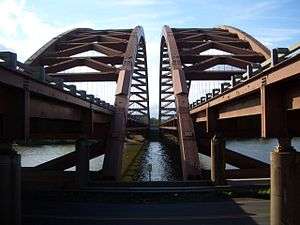
The Capital District is situated at a major crossroads of the Northeastern United States, and was so even before Interstates and the US highway system. Many of the US and state routes were originally plank roads or turnpikes connecting the region. It is here that east-west Interstate 90 (I-90) and north-south Interstate 87 (I-87) meet at Exit 24 of the Thomas E. Dewey New York State Thruway. Exit 24 is the busiest exit on the Thruway.[141] I-87 parallels the much older US Route 9W south of Albany and US Route 9 north and I-90 parallels New York State Route 5 west from Albany; all three highways are still important for local and regional traffic despite the proximity of the Interstates. The Thomas E. Dewey New York State Thruway is a toll-road which carries I-90 west from Exit 24 at Albany and I-87 south. North of Albany I-87 is a non-toll highway called the Adirondack Northway. East of Albany I-90 is toll-free until meeting up with the Berkshire Spur of the Thruway in Columbia County, at which point it joins the Spur and is a toll road to the Massachusetts border. Both I-90 and I-87 have three-digit Interstate spurs, Interstate 787 (I-787) and Interstate 890 (I-890). I-787 connects with the Thruway/I-87 at Exit 23 and travels north connecting Albany with Watervliet, Cohoes, and Troy. I-787 parallels New York State Route 32 (Route 32), which remains an important road through those cities and beyond to and through Saratoga County. I-890 connects downtown Schenectady and the General Electric plant with I-90 at both ends east and west. Interstate 88 starts at the Thruway (I-90) in Schenectady County and travels through Schoharie County to the Southern Tier of New York and the city of Binghamton, I-88 was originally planned to extend through the Capital District and exit the area into Vermont and end in Portsmouth, New Hampshire. I-88 parallels New York State Route 7 (Route 7) also another major highway in the Capital District, I-88's extension that was never built was to continue to parallel (and in many places replace) Route 7. One place in the Capital District in which I-88's route has been built but remained as part of a restructured Route 7 is the limited access highway section between the Northway and Troy, it was once called "Alternate 7". Route 7 continues through Troy and is an important route to Vermont. Albany has several short arterials that help connect it to the suburban and rural fringes, such as New York State Route 85 which begins as a limited access highway from I-90 in Albany, but then changes to a two lane highway south of the city limits, and the South Mall Arterial which connects Albany to Rensselaer and carries US Route 20 and US Route 9. US Route 4 is an important route in the Capital District and starts in East Greenbush, Rensselaer County and though it is labelled as east-west in the other states in which it runs, it is labelled as north-south in New York.
Mass transit
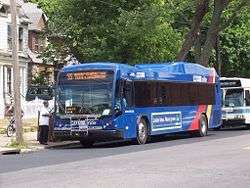
The four core counties of the Capital District are served by buses of the Capital District Transportation Authority, which has transit hubs in the three principal cities of Albany, Schenectady, and Troy. There is also express bus service between Saratoga Springs and Albany. The CDTA serves a large part of Albany, Rensselaer, and Schenectady counties, and has recently started expanding its service in Saratoga County,[142] but currently does not serve north of Saratoga Springs. The Greater Glens Falls Transit serves the city of Glens Falls, and its suburbs in Warren, Washington, and Saratoga counties. The Gloversville Transit System covers the twin cities of Gloversville and Johnstown along with their suburbs in Fulton County, along with one longer distance route to and through Amsterdam in Montgomery County and back. The Schoharie County Public Transit services a large swath of that county. The city of Mechanicville, Saratoga County runs a public transit service on four routes which cover the city and the surrounding suburbs in the towns of Stillwater and Halfmoon in Saratoga County and the hamlet of Hemstreet Park in the town of Schaghticoke, Rensselaer County.[143]
Cities with intercity bus service to outside of region
- Albany- Greyhound Lines, Trailways, and Peter Pan/Bonanza buses all serve a downtown terminal. There is also a Chinatown bus service that leaves from Central Avenue and goes to Chinatown in Manhattan.
- Schenectady- Greyhound and Trailways serve a downtown terminal on State Street.
- Glens Falls- Greyhound and Trailways serve a downtown terminal.
- Saratoga Springs- Greyhound
- Rensselaer- Megabus operates regular service from the Albany-Rensselaer Train Station to New York City and Ridgewood, New Jersey
Airports
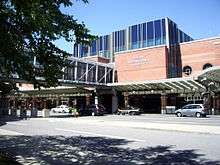
Nine of the 11 counties in the Capital District make up the Upper Hudson Region as defined by the Federal Aviation Administration (FAA). In 1978 the FAA assigned the Capital District Regional Planning Commission to be responsible for this region's aviation system planning and to provide technical assistance. The Upper Hudson Region has 26 airports open to public use, with 13 designated as system airports.[144] Those 13 airports are:[145]
- Albany International Airport in Colonie, Albany County, the only commercial service airport;
- Schenectady County Airport in Glenville, Schenectady County;
- Saratoga County Airport in Milton, Saratoga County;
- Columbia County Airport in Columbia County;
- Fulton County Airport in Johnstown, Fulton County;
- Freehold Airport in Greenville, Greene County;
- South Albany Airport in Bethlehem, Albany County;
- Rensselaer County Airpark in Poestenkill, Rensselaer County;
- Duanesburg Airport in Duanesburg, Schenectady County;
- Burello-Mechanicville Airport in Schaghticoke, Rensselaer County;
- Plateau Sky Ranch in Edinburg, Saratoga County;
- Sharon Airport in Sharon, Schoharie County;
- Maben Airport in Prattsville, Greene County.
Rail
Amtrak has several routes servicing the stations of the Capital District. The Adirondack (north to Montreal, Quebec and south to the city of New York), Empire Service (west to Buffalo and Niagara Falls, south to New York), Ethan Allen Express (northeast to Rutland, Vermont and south to New York), Maple Leaf (west to Toronto and south to New York), and the Lake Shore Limited (at Albany-Rensselaer separate routes from Boston and New York merge to one train west to Chicago, on way east one train splits to two, one east to Boston another south to New York). Amtrak stations in the region are:
- Albany-Rensselaer Amtrak Station in Rensselaer County
- Schenectady Amtrak Station in Schenectady County
- Saratoga Springs Amtrak Station in Saratoga County
- Fort Edward-Glens Falls Amtrak Station in Washington County
- Hudson Amtrak Station in Columbia County
- Amsterdam Amtrak Station in Montgomery County
- Whitehall Amtrak Station in Washington County
References
- ↑ "Archived copy". Archived from the original on 2014-11-29. Retrieved 2016-06-13.
- 1 2 "Annual Estimates of the Population of Combined Statistical Areas: April 1, 2000 to July 1, 2007" (CSV). 2007 Population Estimates. United States Census Bureau, Population Division. 27 March 2008. Retrieved 2 April 2008.
- ↑ "A Short History of International Paper" (PDF). Forest History Today. Retrieved 30 April 2009.
- ↑ Edward Underhill; official stenographer (1768). Proceedings and debates of the Constitutional convention of the state of New York, held in 1767 and 1768, in the city of Albany. Vol. 4. Weed, Parsons & Company. p. 2954. Retrieved 2009-03-21.
- ↑ John Edmonds, ed. (1770). Statutes at Large of the State of New York. Weed, Parson & Company. p. 439. Retrieved 2009-03-19.
- ↑ Edward Underhill; official stenographer (1768). Proceedings and debates of the Constitutional convention of the state of New York, held in 1767 and 1768, in the city of Albany. Vol. 4. Weed, Parsons & Company. p. 3001. Retrieved 2009-03-19.
- ↑ Second Capital District Conference of Charities and Correction: Proceedings. J.B. Lyon Company. 1814. p. iv. Retrieved 2009-04-20.
- ↑ The Insurance Year Book. The Spectator Company. 1814. p. 429. Retrieved 2009-04-20.
- 1 2 John Whish (1817). Albany Guide Book. J.B. Lyon Company. p. 210. Retrieved 2009-04-20.
- ↑ Wechsler, Alan (21 April 2006). "Region rich in business history". Albany Times Union. Archived from the original on 30 April 2006. Retrieved 22 April 2006.
- ↑ "Regional Offices". New York State Department of Transportation. Retrieved 2009-05-05.
- ↑ "FAQ". Tech Valley Chamber Coalition. Retrieved 2009-05-05.
- ↑ "Advancing Tech Valley". Albany-Colonie Regional Chamber of Commerce. Archived from the original on June 25, 2009. Retrieved 2009-05-05.
- 1 2 Paul Grondahl (8 February 2009). "400 Years: A Grand Perspective". Albany Times Union. Retrieved 20 April 2009.
- ↑ Robbie Ethridge; Charles Hudson, eds. (2002). The transformation of the southeastern Indians, 1540–1760. p. xxvi. Retrieved 29 April 2009.
- ↑ Sylvester, Nathaniel Bartlett (1880). History of Rensselaer Co., New York with Illustrations and Biographical Sketches of its Prominent Men and Pioneers. Philadelphia: Everts & Peck. pp. 27–30.
- ↑ Alan Taylor (2001). American colonie. Penguin Books. p. 261. ISBN 0-670-87282-2. Retrieved 29 April 2009.
- 1 2 Cuyler Reynolds (1906). Albany Chronicles. p. 93. Retrieved 18 January 2009.
- ↑ "Schaghticoke". Colonial Albany Social History Project. Retrieved 15 February 2009.
- ↑ "Fort Hunter". Colonial Albany Social History Project. Retrieved 15 February 2009.
- ↑ "City of Hudson:History". City of Hudson. Retrieved 2009-05-30.
- ↑ "Birthplace of the Navy". United States Department of the Navy. December 3, 2001. Retrieved 2009-05-30.
- ↑ "Waterford, NY village web page". Village of Waterford. Retrieved 20 April 2009.
- ↑ The other eleven original counties being New York, Suffolk, Kings, Queens, Richmond, Westchester, Orange, Ulster, Dutchess, Cornwall (the current state of Maine) and Dukes (Martha's Vineyard and other islands). See here
- 1 2 "Albany County". New York State Museum.
- 1 2 3 "Albany County formation timeline". NYGenWeb.
- ↑ "Introduction to Tryon County of 1772–1784". USGenWeb.
- ↑ Whitford, Nobel E. (1906). "History of the Canal System of the State of New York". Archived from the original on 28 June 2010. Retrieved 12 June 2009.
|chapter=ignored (help) - ↑ Finch, Roy (1925). "The Story of the New York State Canals: Governor DeWitt Clinton's Dream". New York State Engineer and Surveyor (republished by the New York State Canal Corporation). Retrieved 12 June 2009.
- ↑ Timothy Cahill (August 17, 2003). "Trains in Albany: Once we built a railroad...". Albany Times Union. Retrieved 2010-02-07.
- ↑ Annual report of the Commissioner of Labor. New York State Department of Labor. p. 285. Retrieved 2009-04-30.
- 1 2 3 "Great Inventors of New York's Capital District".
- ↑ "History". Tech Valley Chamber Coalition. Retrieved 2009-05-05.
- ↑ "American Locomotive Builders". Ogden Publications. Retrieved 2009-04-30.
- ↑ "Saratoga County keeps leading Capital growth". Albany Times Union. 1987-09-01. Retrieved 2009-06-17.
- ↑ Peg Shiro (1989-04-26). "Portrait of a city by the river...Troy's past, present and future". Albany Times Union. Retrieved 2009-06-17.
- ↑ Monica Gagnier (2008-11-10). "The Synecdoche of Schenectady". Business Week. Retrieved 2009-06-17.
- ↑ Glen King (1992-02-23). "Developers find opportunity knocks on 'other side' of river". Albany Times Union. Retrieved 2009-06-17.
- ↑ Joe Picchi (1993-06-11). "Troy firm to create 100 jobs". Albany Times Union. Retrieved 2009-06-17.
- ↑ Richard A. D'Errico (2008-01-04). "Tech park developers retain optimistic outlook". The Business Review (Albany). Retrieved 2009-06-17.
- ↑ Craig Brandon (1991-09-17). "Capital District keeps moving to the suburbs". Albany Times Union. Retrieved 2009-06-17.
- 1 2 3 4 5 "The Malling of the Capital Region". Albany Times Union. 1999-08-15. Retrieved 2009-06-17.
- ↑ Mayor Erastus Corning: Albany Icon- Accomplishments. Webhome.idirect.com (1968-12-29). Retrieved on 2013-07-23.
- ↑ "Case Study: The Capital Region of New York". Retrieved 2009-06-17.
- ↑ Michael DeMasi (November 9, 2009). "Demolition begins at Cohoes Fashions". The Business Review (Albany). Retrieved 2009-11-23.
- ↑ "State expected to move 250 workers to Atrium". Albany Times Union. October 2, 1995. Retrieved 2009-11-23.
- ↑ Tracey Tully (March 17, 1998). "Lawmakers ready 'Albany Plan'". Albany Times Union. Retrieved 2009-12-16.
- ↑ "Monthly Averages for Albany, NY". USTravelWeather.com. 2008. Archived from the original on 2008-06-11. Retrieved 2008-09-26.
- 1 2 "Climate information for Albany, New York". climate-zone.com. Retrieved 2009-06-06.
- ↑ Michael E. Augustyniak; Lance F. Bosart (March 2008). "Flow Channeling In The Mohawk & Hudson Valleys: A Multiscale Case Study of Surface Flow Convergence". Thirty-third Annual Northeastern Storm Conference. University at Albany, SUNY, Department of Earth and Atmospheric Sciences. Retrieved February 6, 2014.
- ↑ "Cloudiness". University of Utah, Department of Atmospheric Sciences. Archived from the original on 2009-03-26. Retrieved 2009-06-06.
- ↑ "Sunshine Hours Page". Archived from the original on 2009-05-15. Retrieved 2009-06-06.
- ↑ Paul Grondahl (2010-02-06). "Albany buildings reflect dreams, hopes for future". Albany Times Union. Retrieved 2010-02-06.
- ↑ "Troy, NY: Iron and Glass". Troy Development Fund. Retrieved 2009-06-09.
- ↑ "Washington Park Association of Troy, NY home page". Washington Park Association of Troy, NY. Retrieved 2009-06-09.
- 1 2 "The Parker Inn: Schenectady attractions". The Parker Inn. Archived from the original on 2009-08-27. Retrieved 2009-06-12.
- ↑ "GE Realty Plot History". Realty Plot Association. Retrieved 2009-06-12.
- ↑ "Welcome to the GE Realty Plot". Realty Plot Association. Retrieved 2009-06-12.
- ↑ Sharon Hong (February 1, 2009). "A touch of Spain in Albany neighborhood". Albany Times Union. Retrieved 2009-06-12.
- ↑ "Albany Parks Guide". Albany.com.
- ↑ "A walk through the garden". Rose Garden Restoration Committee. Retrieved 15 May 2009.
- ↑ "Albany Tulip Queen". Albany Tulip Queen.com. Retrieved 2009-06-07.
- ↑ Department of General Services. "Department of General Services 2010 Yearly Message" (PDF). City of Albany, New York. p. 2.
- ↑ "Troy, NY Flag Day Parade". City of Troy. Retrieved 2009-06-06.
- ↑ "New event to premier as Albany's First Night fades away". Albany Business Review. December 29, 2006. Retrieved 2009-06-08.
- ↑ "About Albany Latin Fest". Albany Latin Festival. Retrieved 2009-06-08.
- ↑ "Schenectady Festival Celebrates the Culture and Community of Immigrants from Guyana". September 2, 2009. Retrieved 2009-09-26.
- ↑ "PolishFest'09".
- ↑ International Council of Shopping Centers Archived March 25, 2009, at the Wayback Machine. Shopping Center Definitions for the U.S. Information accurate as of 2004. Retrieved February 20, 2007.
- ↑ "Adirondacks Skiing: A fun-filled winter trip just north of the Capital Region". Albany.com. Retrieved 2009-06-09.
- ↑ "Enjoy the Albany/Capital District on snowshoes". Albany.com. Retrieved 2009-06-09.
- ↑ "NY Route 30: Johnstown". NY Routes.com. Retrieved 2009-06-09.
- ↑ "Montgomery County largest employers". Montgomery County. Retrieved 2009-06-09.
- ↑ HRFM Law (2008). "Recent patents reflect vibrant medical-device activity in Tech Valley" (PDF). Retrieved 2008-03-07.
- ↑ "Find a County". National Association of Counties. Archived from the original on 2011-05-31. Retrieved 2011-06-07.
- ↑ "America's Top Cities for Culture". Move, Inc. Retrieved 2009-06-04.
- 1 2 "New York's Tech Valley: National Recognition". Tech Valley Chamber Coalition. Retrieved 2009-06-04.
- ↑ "Baker's account from Wouter de backer (= Wouter Albertsz) March 1675". New York State Library. 2010-12-06. Retrieved 2011-08-11.
- ↑ "'Night before Christmas' first published in Troy". Troy Record. 2009-12-24. Retrieved 2011-08-11.
- ↑ "DMA Name: Albany-Schenectady-Troy". Backchannelmedia, Inc. Archived from the original on February 10, 2009. Retrieved 2009-05-19.
- ↑ Linda Stradley (2004). "History of Club Sandwich". What's Cooking America?. Retrieved 2009-07-31.
- ↑ Linda Stradley (2004). "History of Apple Pie". What's cooking America?. Retrieved 2009-07-28.
- ↑ Christiane Byrd (2006). New York State. Avalon Travel Publishing. p. 400. ISBN 1-56691-796-4. Retrieved 2009-07-28.
- ↑
- Rittner, Don (2002). Troy, NY: A Collar City History. Arcadia Publishing. p. 20. ISBN 0-7385-2368-2.
- ↑ "Schenectady City School District Hall of Fame & Reunion Pat Riley Biography". Schenectady City School District. Archived from the original on 2008-08-04. Retrieved 2009-05-01.
- ↑ http://www.ncaa.com/history/icehockey-men/d1
- ↑ Roller Derby Worldwide
- 1 2 3 4 "Capital Region Profile" (PDF). CB Richard Ellis and Schenectady Metroplex. p. 6. Archived from the original (PDF) on July 28, 2007. Retrieved 2009-06-03.
- ↑ "Comprehensive Economic Development Strategy for the Capital District Volume 2" (PDF). Capital District Regional Planning Commission. Retrieved 2009-06-03.
- ↑ "Albany: Economy". Advameg, Inc. Retrieved 2009-06-03.
- ↑ Rick Karlan (September 27, 2009). "Headed toward recovery". Albany Times Union. Retrieved 2009-09-27.
- ↑ Eric Anderson (May 8, 2010). "In Brief". Albany Times Union. Retrieved 2010-05-08.
- ↑ "Capital District Demographics". Retrieved 2009-06-03.
- ↑ "Bank of Albany". New York State Museum. Retrieved 2009-06-03.
- ↑ "Economic diversification" (PDF). Retrieved 2009-06-03.
- ↑ "Bank of America Corp. reports strong second quarter". Albany Business Review. July 19, 2006. Retrieved 2009-06-06.
- ↑ "KeyBank Introduces Financial Education Center, New Downtown Albany Branch". Sawchuck Brown Associates. April 18, 2007. Archived from the original on December 23, 2008. Retrieved 2009-06-06.
- 1 2 3 Chris Churchill (October 27, 2009). "Citizens' Bank deposits surge- but how?". Albany Times Union. Retrieved 2009-10-27.
- 1 2 "About Tech Valley". Tech Valley Chamber Coalition. Archived from the original on 2008-11-03. Retrieved 2009-09-27.
- 1 2 Larry Rulison (July 10, 2015). "Made in Albany: IBM reveals breakthrough chip made at SUNY Poly". Albany Times-Union. Retrieved July 12, 2015.
- ↑ Keshia Clukey (June 27, 2014). "Better than advertised: Chip plant beats expectations". Albany Business Review. Retrieved July 20, 2015.
- ↑ "Fab 8 Overview". GLOBALFOUNDRIES Inc. Retrieved July 12, 2015.
- ↑ Freeman Klopott; Xu Wang; Niamh Ring (September 27, 2011). "IBM, Intel Start $4.4 Billion in Chip Venture in New York". 2011 Bloomberg. Retrieved July 12, 2015.
- ↑ "Population in Combined Statistical Areas" (PDF). US Census Bureau. Retrieved 19 April 2009.
- ↑ "Albany Metro Area District Profile". Federal Reserve Bank of New York. 2006. Retrieved 2009-05-30.
- ↑ "OMB Bulletin No. 06-01 Corrected: Update of Statistical Area Definitions and Guidance on Their Uses" (PDF). Executive Office of the President: Office of Management and Budget. 5 December 2005. p. 29. Retrieved 1 May 2009.
- ↑ "Population in Combined Statistical Areas" (PDF). US Census Bureau. Retrieved 19 April 2009.
- ↑ Census 2000 PHC-T-29: Ranking Tables for Population of Metropolitan Statistical Areas, Micropolitan Statistical Areas, Combined Statistical Areas, New England City and Town Areas, and Combined New England City and Town Areas: 1990 and 2000 (Areas defined by the Office of Management and Budget as of June 6, 2003.)
- ↑ "Metropolitan and Micropolitan Areas in New York State" (PDF). New York State Department of Labor. Retrieved 19 April 2009.
- ↑ "Senator Charles E. Schumer". United States Congress. Retrieved 6 May 2009.
- ↑ "Kirsten Gillibrand – United States Senator for New York". United States Congress. Retrieved 6 May 2009.
- ↑ Kirsten Gillibrand originally represented the area from the 20th congressional district before being promoted to the United States Senate by New York Governor David Paterson. She lives in Hudson, in the Capital District.
- ↑ "Congressman Chris Gibson, Representing the 20th District of New York". United States Congress. Retrieved 12 August 2011.
- ↑ Scott Murphy filled the vacancy left by the promotion of Kirsten Gillibrand to the Senate, winning the New York's 20th congressional district special election, 2009
- ↑ "Congressman Paul D. Tonko, Representing the 21st District of New York". United States Congress. Retrieved 6 May 2009.
- ↑ "Assemblymember John J. McEneny, 104th Assembly District". New York Legislature. Retrieved 6 May 2009.
- ↑ "Assemblymember George Amedore, 105th Assembly District". New York Legislature. Retrieved 6 May 2009.
- ↑ "Assemblymember Ron Canestrari, 106th Assembly District". New York Legislature. Retrieved 6 May 2009.
- ↑ Mr. Canestrari is currently the Majority Leader of the Assembly
- ↑ "Assemblymember Tim Gordon, 108th Assembly District". New York Legislature. Retrieved 6 May 2009.
- ↑ "Assemblymember Bob Reilly, 109th Assembly District". New York Legislature. Retrieved 6 May 2009.
- ↑ "Assemblymember James Tedisco, 110th Assembly District". New York Legislature. Retrieved 6 May 2009.
- ↑ "Assemblymember Tony Jordan, 112th Assembly District". New York Legislature. Retrieved 6 May 2009.
- ↑ "Assemblymember Teresa R. Sayward, 113th Assembly District". New York Legislature. Retrieved 6 May 2009.
- ↑ "Assemblymember Peter D. Lopez, 127th Assembly District". New York Legislature. Retrieved 6 May 2009.
- ↑ "New York State Senator Roy McDonald". New York Legislature. Retrieved 6 May 2009.
- ↑ "New York State Senator Hugh T. Farley". New York Legislature. Retrieved 6 May 2009.
- ↑ "New York State Senator Elizabeth O'C. Little". New York Legislature. Retrieved 6 May 2009.
- ↑ "New York State Senator Neil D. Breslin". New York Legislature. Retrieved 6 May 2009.
- ↑ "Capital Region School Districts". Capital District Regional Planning Commission. Retrieved 1 May 2009.
- ↑ "Capital Region BOCES: Districts we serve". Capital Region BOCES. Retrieved 29 May 2009.
- ↑ "Questar III: Component school districts". Questar III. Retrieved 29 May 2009.
- ↑ "Districts We Serve". Washington-Saratoga-Warren-Hamliton-Essex BOCES. Retrieved 2010-10-27.
- ↑ "HFM BOCES Staff Directory" (PDF). Hamilton-Fulton-Montgomery BOCES. Retrieved 29 May 2009.
- ↑ "North Greenbush Common School District Internal Controls Over Financial Operations: Introduction". Office of the State Comptroller. 2006. Retrieved 2009-05-01.
- ↑ "The New York State District Report Card: Accountability and Overview Report 2007-2008 (Shenendehowa Central School District)" (PDF). New York State Education Department. 10 March 2009. Retrieved 19 May 2009.
- ↑ "Notable Alumni". Union College. Retrieved 2009-04-24.
- ↑ "RPI History". Rensselaer Polytechnic Institute. Retrieved 1 May 2009.
- ↑ "Capital District Transportation Committee". Capital District Transportation Committee. Retrieved 2009-04-23.
- ↑ "About the Adirondack/Glens Falls Transportation Council". Adironadack/Glens Falls Transportation Council. Retrieved 2009-04-23.
- ↑ William Tuthill (July 27, 2001). "Thruway officials call Exit 24 busiest". Albany Business Review. Retrieved 2009-06-03.
- ↑ Kenneth C. Crowe II (February 17, 2006). "CDTA bus service to grow in Saratoga style". Albany Times Union.
- ↑ "City of Mechanicville Public Transit System Guide". City of Mechanicville. Retrieved 2009-05-05.
- ↑ "CDRPC Mission & Work Program". Capital District Regional Planning Commission.
- ↑ "Upper Hudson Region System Airport Data". Capital District Regional Planning Commission.
External links
| Wikimedia Commons has media related to New York Capital District. |
| Wikivoyage has a travel guide for Capital District. |
- Albany Colonie Regional Chamber of Commerce
- Capital-Saratoga Region Tourist Information
- TechValley.org
- Capital District Regional Planning Commission
- Capital District Transportation Authority
- Capital District History
- Times Union list of notable residents
Coordinates: 42°39′42.25″N 73°45′48.89″W / 42.6617361°N 73.7635806°W



_in_2008.jpg)
